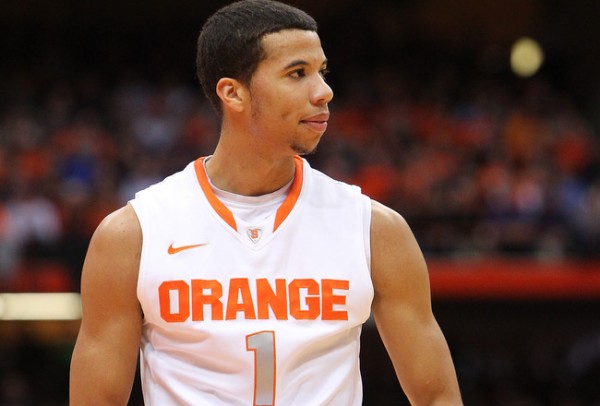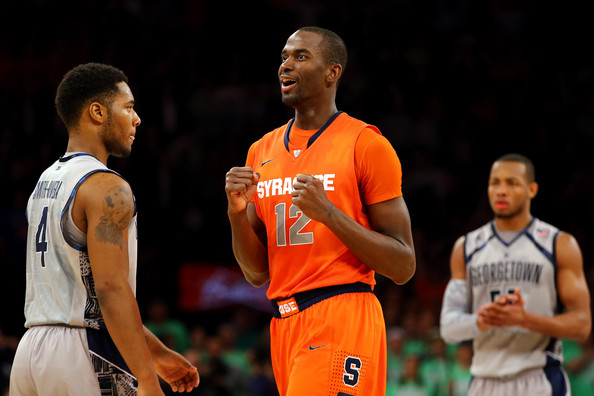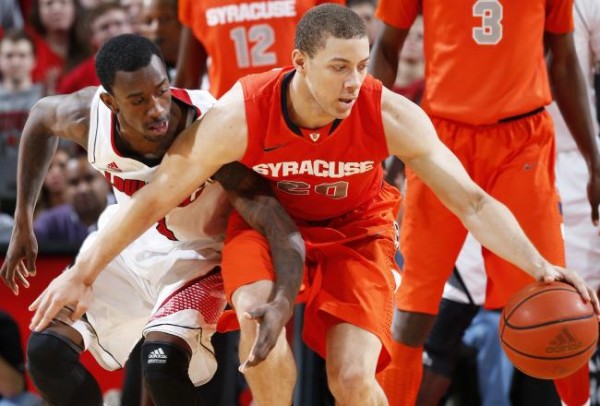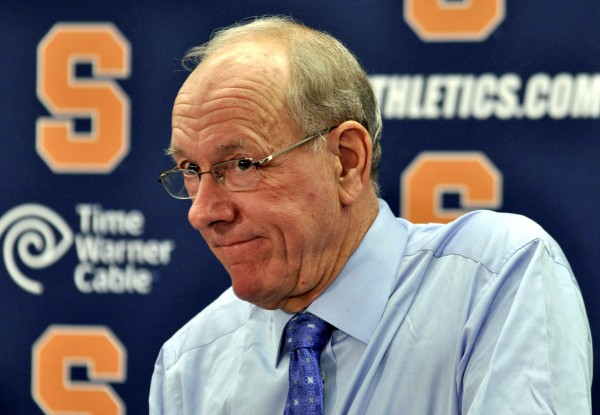Final Four Previews In-Depth: Syracuse Orange
Posted by Chris Johnson on April 5th, 2013It would have been easy to lose faith in Syracuse near the end of the regular season. The Orange sputtered to a 5-7 finish over their last 12 games, which in itself was enough point-blank evidence to jump off the bandwagon. The swirling rumors of NCAA impropriety and looming specter of coach Jim Boeheim’s retirement added to the general malaise that fell over this program as it hobbled into the final Big East Tournament at Madison Square Garden. What’s happened since? This In-Depth Final Four preview, the last installment of our four-part series, should give you a pretty good idea. The Orange are to be feared, and this, in long form, is my explanation why.
(Revisit previous entries Wichita State, Michigan and Louisville)

Smart and controlled point guard play from MCW has pushed Syracuse into the Final Four (Getty Images).
Pre-Tournament Capsule. Non-conference schedules in Syracuse, New York, are unfailingly bland subjects. The Orange hardly ever leave the state of New York, and when they do – as was the case this season when they opened the season by traveling across the country to play San Diego State on top of the USS Midway aircraft carrier, as well as an SEC-Big East challenge game at Arkansas – it’s extremely rare and/or typically not of their own volition. The Orange “ventured” to Madison Square Garden three days before Christmas and took their only loss before Big East play, a four-point defeat to Temple. They buzzed through the early part of conference play looking like one of the four or five best teams in the country, with wins at Louisville and home Notre Dame sprinkled therein. Things got ugly in the portion of the hoops calendar we like to call the “dog days” – the mid-to-late February stretch of conference play where teams start running on fumes at the tail end of a long league schedule. The Orange dropped four of five to close the regular season, then got off the mat and played their way into the Big East Tournament championship game, an emotional conference sendoff that ended with fellow ACC-bound member Louisville tearing the lid off MSG in a pristine second-half effort. Syracuse may have fallen in the finals, but that ugly stretch at the end of conference play was officially a figment of the past. The Orange were ready for the Big Dance.
How They Got Here. There was nothing circuitous or fluky about Syracuse’s path to Atlanta. They drubbed Montana in a game many thought could give the Orange real problems (HA!), pulled away from Cal in a hard-fought second half, put the nation’s then-No. 1 efficiency offense (Indiana) in the 2-3 blender and dropped Big East foe Marquette in the Elite Eight. Looking back, astonishing as it may seem, that round-of-32 bout with Cal was, I’d argue, the most trying game Syracuse has played in this year’s NCAA Tournament.
Final Four History. Only one of Syracuse’s Final Four appearances came before Boeheim inherited the head coaching job in 1976, and Boeheim was very much a part of that one too, only in a different capacity. When Syracuse reached the national semifinals in 1975, Boeheim had been an assistant for six seasons. Little did he know the head coaching job would open up one year later, and the rest – the four Final Four appearances, the 900 wins and counting, the national championship – became part of the legendary coaching monolith we know invariably associate with Syracuse basketball. Boeheim’s last Final Four trip with the Orange was led by one of the most dominant freshman stars in the modern hoops era and ended with a title. That would be Carmelo Anthony circa 2003.

The nation’s best shot-blocking team has an improved Baye Moussa Keita protecting the rim in Tournament play (Getty Images)
Season High Point. In one of the most impressive road wins of the season, Syracuse traveled south to the swanky KFC Yum! Center on January 19 to trade blows with No. 1 Louisville. The Cardinals had lost just one game at that stage of the season, an asterisk-warranting defeat to Duke in the Battle 4 Atlantis Final (center Gorgui Dieng was held out due to injury), and nothing would have better cemented Louisville’s Big East and national stature than a thorough whipping of conference rival Syracuse. Michael Carter-Williams made amends for a lamentable first half by scoring nine of his team’s final 11 points to push the Orange over the top in a gritty two-point win. It was an enormous triumph and a resounding statement for Big East and national title contenders everywhere.
Season Low Point. I gave this away earlier in the post, but Syracuse’s four-of-five losing swoon to close Big East play was a troublesome late-season trend. After all, the goal is to save your best basketball for the end of February and March; the kinks exposed in a multi-game losing streak should already have been taken care of by then. Syracuse quickly corrected those mistakes, because otherwise, the Orange would have seen their Tournament run end in the first weekend. In the end, that mini-tailspin obscured an otherwise successful, and a team – as we now well know – dangerous enough to win a national championship. Now you get the feeling the Orange were merely trying to throw everyone off the scent, to sneak into the NCAAs with a lower-profile (and higher seed) than their talent and season CV rightfully deserved.
What’s Working. This section might as well be re-titled to say: “What’s been working for the past 37 years?” Of the four teams remaining, Syracuse might be the easiest to scout. That’s certainly the case on defense, where the Orange attack opponents with the same 2-3 zone that’s worked under Boeheim’s watch for over three decades, that continues to work regardless of the individuals commissioned, that’s become the defining trait of Boeheim’s enduring success. The difference now? Opposing teams have no recourse to salvage even a half-passable offensive performance, because the only way to beat the 2-3 is to know it, and the only way to know it is to have experienced it. Syllogistically, what I’m saying, is that teams with no experience going up against the zone are clueless as how to how to approach it, let alone dissect or penetrate it. Not even Big East opponent Marquette could find a distinctive weakness. The 2-3 is alive and well, and no one has been able to slow it down.
What’s Not Working. Here I go, tweaking labels on the fly once more: It’s not about “what’s not working” so much as it is what might not work. I don’t doubt Syracuse’s ability to generate offense on the break and run effective stuff in the half court and summon timely outside shooting from James Southerland. It’s the other side of the equation – the offensive murderer’s row headed by Trey Burke, anchored by Mitch McGary and aided by Tim Hardaway Jr. and Nik Stauskas – that gives me pause in Saturday’s match-up. Michigan’s offense ranks number one in Ken Pomeroy’s efficiency metrics, which makes even historically dominant defenses like Syracuse’s liable to a potential dam-breaking point-allowance hiccup. The Wolverines can really score it, and if Syracuse’s defense isn’t getting as many stops as it was in previous rounds, suffice it to say the Orange may have some trouble keeping up with Burke and company. Syracuse can guard; the question is whether in can do enough offensively, in the event their 2-3 is gutted by the best offense in the country.

working in lockstep to invade passing lanes and get deflections at the top of the 2-3 zone, Triche is crucial to Syracuse’s famous defense (Getty Images).
Why Syracuse Will Win It All. When you think of all the great basketball leaders that built the Big East into the preeminent college basketball conference in the country, you think about Dave Gavitt and Jim Calhoun and John Thompson. Most of all, you think about Boeheim. He elevated the Orange, and the league more broadly, to stratospheric heights. He cultivated brotherhood and a hard-nosed hoops culture among a tight-knit group of northeastern schools. He represented the league on the highest stage of competition. And now, all of it comes crumbling down, thanks to football, greedy conference commissioners and university presidents and TV money, and you can rest assured Boeheim is none too thrilled about it. What better way to end his long and storied run in the conference he helped nurture with a career-defining national championship trophy? I suppose Louisville winning it all would have a similar effect, but Syracuse was a charter member, and Boeheim a Big East forefather. He is Big East down to his elemental core. The Orange can commemorate the death of their great long-time league with the biggest national prize available.
Why Syracuse Won’t Win it All. Where Syracuse is good, Louisville is better. The Orange are defending better than ever before this season; Louisville gives up the fewest points per trip (0.82 PPP) in the country. The Orange have a dynamic point guard with unparalleled distribution skills and underrated defensive value; Russ Smith is playing the best basketball of his life and is running away with the NCAA Tournament’s Most Outstanding Player award. I can go on and on, rattling off Louisville’s advantages and comparatively casting doubt on Syracuse’s chances to win this thing. All it is, really, is a reasonable assessment of the situation: if Syracuse gets by Michigan (a huge if, to be sure), they won’t get by Lousville, by far the best team in the country peaking at the perfect moment in time. I can’t find anything specific to impeach the Orange’s claim to a national title – the offense isn’t UM-level elite, I guess, but nobody’s is! The monster on the other side of the bracket holds the key to their demise.














































